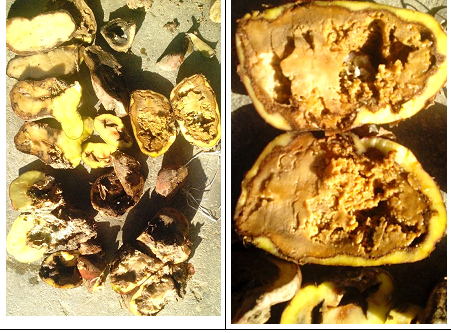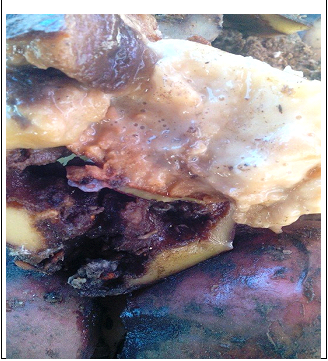Editorial
Volume 2 Issue 1 - 2018
A Report of Late Blight Disease of Potatoes Caused by Phytophthora Infestans in Gilgit-Baltistan (GB) Pakistan
Department of Plant Pathology, the University of Agriculture, Peshawar Pakistan
*Corresponding Author: Aqleem Abbas, Department of Plant Pathology, the University of Agriculture, Peshawar Pakistan.
Received: December 24, 2017; Published: January 09, 2018
Introduction
Potato (Solanum tuberosum L.) is the most significant food as well as cash crop of the world after cereals such as wheat, rice and maize (Abbas., et al. 2016). It produces more calories per hectare as compared to rice and wheat (Poehlman and Slepper, 1995; Hylla., et al. 1998). It is one of the member of Solanacea family which also included chilli, eggplant, tobacco and tomato (Hijmans, R.J. and D.M. Spooner. 2001).
Though it has originated in the Andes region and from there it reached to subcontinent by Portuguese traders. Now it has become an integral part of almost every dish in Pakistan. Pakistan having unique weather is suitable for the production of potato (Anon 2017). In Pakistan, potato is grown over an area of 174.4 thousand hectares with a total production of 3802.3 thousand tons and the average yield was recorded 22 tons per hectares (GOP, 2016).
For the past decade, the production of potato has increased in Gilgit Baltistan (GB) region of Pakistan. The reasons might due to increased acreage as well as due to the introduction of new cultivars. Currently it has become major source of income for the farmers. The production of potato crop in 2017 was approximately 20 bags (Each bag was of 70-80Kg) per one-eighth of an acre (510 m2) land.
However to estimate total annual potato production of GB is difficult to do accurately due to the fact that the region is highly mountainous and crop mature at different dates depending on the altitudes of potato growing areas. Since the disease resistant traditional varieties of plants have been replaced by high yielding but susceptible varieties. As a result major threats come in the form of various diseases.
Among these diseases late blight is the most important one affecting potatoes (Agrios, 2005; Ahmad & Mirza, 1995). The causal agent of the late bight is Phytophthora infestans (Mont.) de Bary, which is not only limiting the production of potatoes in GB but also worldwide (Younas., et al. 2009). Currently in GB it is the most destructive disease of because of its increasing distribution potential.
The potato cultivars were introduced to GB from the Kalam and Malam Jaba valleys of Swat district of Pakistan in 1990s. Ever since late blight has been found from all the potato growing areas of GB notably in the elevated valleys such as Nalter, Nomal and Dayetar Valleys. GB has a cooler climate so the climate is favorable to pathogen. However the pathogen has potential to adapt a diverse range of environmental conditions. The disease has devastating effects on potato tubers (Figure 1) as well as foliage.
The temperate as well as other climatic conditions (Tosun., et al. 2007) of GB are favorable for the rapid multiplication of this diseases. The recent erratic and Hugh rainfall have also contributed in the increment of this disease. The pathogen is found to infecting all stages potato crop stems along with the tubers and leaves are also found to be infected. Whitish cottony growth on the lower side of foliage and on the edges of the leaves. Brownish green lesions are fond on the uppers side of foliage. However the dark brown or black lesions were observed on the petioles and stems. Potato tubers were found to be rotting (Figure 2).
Conclusion
Late blight of potato can be controlled by the integrated disease management (IDM) strategy (Parvez., et al. 2003). The ideal way to combat this disease is through the development of resistant cultivars. However, there is not any such Plant Breeding and Plant Pathology institute in GB for the screening of potato germplasm against late blight of potato. Currently every commercial variety is susceptible to late blight disease.
In other provinces of Pakistan new varieties have been developed however need to be test for the presence of resistance genes to late blight disease. Fungicides may play an important role in reducing the incidence of late blight however in GB the farmers have no access to fungicides. Moreover the application of fungicides may reduce the local diversity of other organisms as well as pollute the environment.
Acknowledgements
The research was partially funded by Higher Education Commission (HEC) of Pakistan on Fee Reimbursement Scheme for PhD students.
The research was partially funded by Higher Education Commission (HEC) of Pakistan on Fee Reimbursement Scheme for PhD students.
References
- Abbas A., et al. “A review paper on Potato leaf roll virus (PLRV) of Potatoes in Pakistan”. Asian Journal of Agriculture and Biology 4 (2016): 77-86.
- Agrios GN. “Plant Pathology”. Academic Press (2005): 106-107.
- Ahmad I and J I Mirza. “Occurrence of A2 mating type of Phytophthora infestans in Pakistan”. 23-25.
- Anonymous. “Agricultural Statistics of Pakistan”. Govt. of Pakistan. Ministry of Food, Agriculture, and Livestock. Food, Agriculture & Livestock Division (Economic Wing), Islamabad. (2017):
- GOP. “Agricultural statistics of Pakistan”. Ministry of food, agriculture and livestock, economic affair wing, Islamabad (2016):
- Hijmans RJ and DM Spooner. “Geographic distribution of wild potato species”. American Journal of Botany 88.11(2001): 2101–2112.
- Hylla SA., et al. "Effects of resistant starch on the colon in healthy volunteers: possible implications for cancer prevention". The American Journal of Clinical Nutrition 67.1 (1998): 136–142.
- John Milton Poehlman David Allen Sleper. “Breeding Field Crops”. 4th Edition Iowa State University Press (1995): 419-433.
- Parvez E., et al. “Evaluation of different protectant and eradicate fungicides against early and late blight of potato caused by A. solani (Eliss and Mart) Jones and Grouht and Phytophthora infestans (Mont.) De Barry under field conditions”. Pakistan Journal of Biological Sciences 6.23 (2003): 1942-1944.
- Tosun N., et al. “Genetic variation among Phytophthora infestans (tomato blight) isolates from western turkey revealed by inter simple sequence repeat (issr) and random amplified polymorphic dna (rapd) markers”. Pakistan Journal of Botany 39.3 (2007): 897-902.
- Younis M., et al. “Genotypic variations among different potato lines/varieties for tolerance against late blight disease”. Pakistan journal of phytopathology 21.1 (2009): 13-17.
Citation:
Aqleem Abbas. “A Report of Late Blight Disease of Potatoes Caused by Phytophthora Infestans in Gilgit-Baltistan (GB) Pakistan”.
Clinical Biotechnology and Microbiology 2.1 (2018): 271-273.
Copyright: © 2018 Aqleem Abbas. This is an open-access article distributed under the terms of the Creative Commons Attribution License, which permits unrestricted use, distribution, and reproduction in any medium, provided the original author and source are credited.
































 Scientia Ricerca is licensed and content of this site is available under a Creative Commons Attribution 4.0 International License.
Scientia Ricerca is licensed and content of this site is available under a Creative Commons Attribution 4.0 International License.